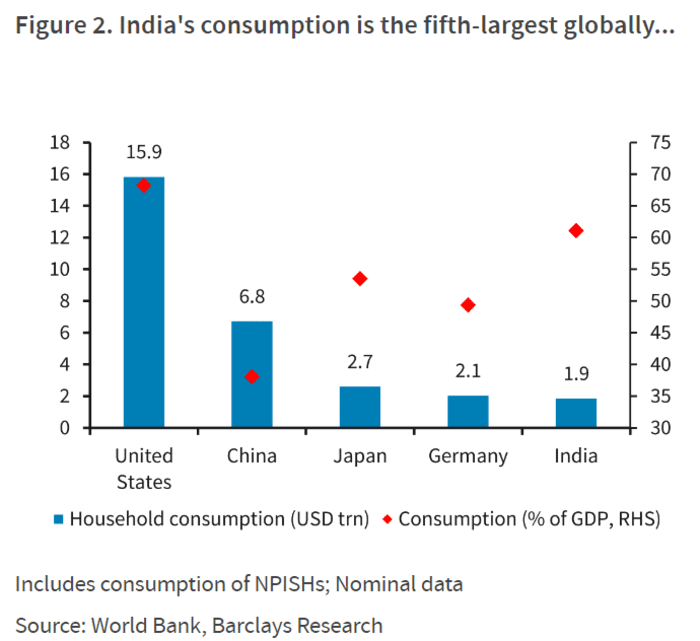India is capturing investors’ attention, as exchange-traded funds targeting stocks in the emerging market extend their climb in 2024.
The country’s economy, which stands to benefit from a changing global supply chain, is expected to expand faster than China’s this year. India’s demographics are particularly appealing, according to analysts.
Equity ETFs focused on India have raked in $3.7 billion of inflows in the past year as of Jan. 30, more than half of which went to the iShares MSCI India ETF INDA at about $2 billion, according to FactSet data.
By contrast, ETFs targeting Chinese equities have suffered about $2.9 billion of outflows over the same period, including around $1.5 billion from the iShares MSCI China ETF MCHI.
Chinese stocks are struggling. Shares of the iShares MSCI China ETF tumbled almost 32% over the 12 months through Jan. 31, while the iShares MSCI India ETF soared nearly 22% over the same stretch, FactSet data show.
Beaten-down Chinese stocks have weighed on the iShares MSCI Emerging Markets ETF EEM, which tracks an index of emerging-market companies weighted by their market value.
China was the biggest geographic exposure of the iShares MSCI Emerging Markets ETF at the end of last year, representing about 26.5% of its portfolio, according to the fund’s fact sheet. India ranked second at 16.7%, followed by Taiwan at about 16%.
“We believe the Indian consumer will be a primary growth engine for both the Indian and the global economy,” Barclays analysts said in a research note dated Jan. 24.
“As incomes rise, India’s consumption is expected to expand with higher discretionary spending,” they wrote. “The country’s consumption is primed for world-beating growth, and could reach the size of China’s current consumption with an economy only ~68% of China’s present size.”
India had $1.9 trillion in nominal consumption in fiscal year 2023, according to their note.

“India is now the world’s most populous country with a young and expanding population,” said the Barclays analysts, pegging its population at around 1.4 billion. “By 2030, India’s population pyramid will show a bulge in the 25-45 age group — the key consuming demographic — which has historically coincided with consumption booms in other economies with similar demographic profiles.”
The International Monetary Fund said in a January report that economic growth in India will “remain strong” in 2024, estimating that its gross domestic product will increase 6.5%.
“A key reason for the unwavering optimism of markets and investors alike around India has been the pivot away from China, amid a desire to build up supply chain resilience,” the Barclays analysts said in a September note.
At that time, they described India as one of the most favorable “investment destinations for global manufacturers outside of China.”
Investor interest in the iShares MSCI India ETF has recently picked up when tracking its average monthly value of trading volume relative to the iShares MSCI China ETF, according to MarketWatch calculations using FactSet data.
The value of the fund’s monthly average trading volume briefly surpassed that of the iShares MSCI China ETF in September, and it recently appeared close to doing so again, as prices of its shares press higher.
On Wednesday, shares of INDA finished at almost $50, a price level it has not surpassed in a close since November 2021, while MCHI was hovering just above its 15-month low hit last week, according to FactSet data.
“There’s tremendous opportunity in India,” said Jeffrey Gundlach, chief executive officer and chief investment officer of DoubleLine, in a live interview with Pensions & Investments that he posted on X on Jan. 24. “I’m not talking about the next 30 months. I’m talking about the next 30 years,” he said. “If I had to own one market in the world, and I had to leave it alone for 30 years, I would buy India.”
The iShares MSCI India ETF’s top five holdings as of Jan. 31 were in the energy, information-technology and financials sectors, including Reliance Industries
500325,
Gundlach said he has been “bullish on the long-term prospects for India, for the Indian market, for years,” pointing to the country’s “fantastic demographics” and describing them as “way better than China.”
India doesn’t appear to make the cut for the Freedom 100 Emerging Markets ETF FRDM, which weighs personal and economic freedom metrics in its stock selection. The biggest country weights for the ETF, which also currently excludes China from its portfolio, were Taiwan, Chile, South Korea and Poland as of Jan. 30, data on the fund’s website show.
Meanwhile, shares of ETFs targeting stocks in India are up this year, after soaring over the past 12 months.
Shares of the iShares MSCI India ETF and Franklin FTSE India ETF FLIN each rose more than 2% in January, while shares of the WisdomTree India Earnings Fund EPI jumped 4.1% last month, FactSet data show.
“India’s stock market is now bigger than Hong Kong’s, indicative of the shift in investment and orders from China to India,” said Chris Low, chief economist at FHN Financial, in a note emailed Jan. 23. “It’s another reminder deglobalization is really reglobalization.”
Steve Goldstein contributed to this article.








